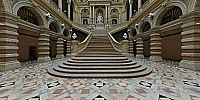The jury selected the design of Viennese architect Alexander Wielemans, Edler von Monteforte (1843-1911) and work began on the foundations in May, 1875. In 1881, the building and its interior (a major example of what was to become known as Historicism) was completed and Emperor Franz Josef I performed the ceremonial laying of the final stone on May 22, 1881. Having cost a total of 2.75 million Guilders, the new building housed the Supreme Court of Justice and Cassation together with the Procurator General's Office, the Higher Regional Court of Appeal for Lower and Upper Austria and Salzburg (together with the Senior Public Prosecutor's Office), the Vienna Regional Court for Civil Matters and the Vienna Commercial Court. Since then, the building has been witness to many twists and turns of history.
From the beginning, the basic shape of this monumental building has been a 100M x 80M rectangle; its main facade faces Ringstrasse and Parliament from behind what is known today as the Grete-Rehor Park (previously the Schmerling Park). The main entrance on the northern side of the building is reached via a 14M wide staircase (with access ramps), the bottom ends of which are decorated with two mighty lions (by South Tyrolean sculptor Emanuel Pendl). At the end of the 1990s, the outer facade was completely renovated and is noteworthy for its fine artistic detail.
The large central hall or Aula is a three-story glass-roofed arcade courtyard with a larger-than-life marble statue of Justitia (also sculpted by Pendl). She is seated, holding a golden sword and a book of laws. The arch panels above the columns contain the Coats of Arms of the kingdoms and Länder represented in the Imperial Council when the building was completed and for which the Supreme Court was their one common judicial forum. Opposite the niche containing the statue of Justitia there is an ornamental clock, while above the statue one sees the former Imperial Austrian Coat of Arms. The Aula attracts many Austrian and foreign visitors and is also a venue for ceremonial events.
On the first floor, on the side housing the Supreme Court, is the Great Foyer, on whose wall the names of all the Presidents of the Supreme Court are inscribed in marble. Likewise on the first floor are the courtrooms for the Supreme Court and the Higher Regional Court of Appeal, reconstructed to be true to the historic originals; inscriptions above the entrances recall the past Presidents of the Vienna Higher Regional Court of Appeal.
More on http://www.ogh.gv.at/justizpalast/index.php?nav=25
Und in Deutsch auf Wikipedia: http://de.wikipedia.org/wiki/Justizpalast_(Wien)




 Tap or click the zoom icon in the bottom right corner of the picture to switch between in-page and fullscreen view
Tap or click the zoom icon in the bottom right corner of the picture to switch between in-page and fullscreen view